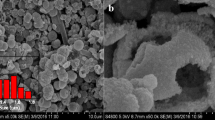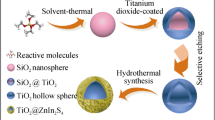Abstract
With the energy crisis and resource depletion nowadays, novel, highly performing, and cost-effective semiconductors are in urgent demand for efficiently harvesting solar energy for photoelectrochemical applications. Herein, this study presents low-cost anatase TiO2 hollow nanoparticles as prepared by a critical liquid-phase deposition (LPD) processing combined with a hydrothermal reaction and calcination processing, without involving any templates. The additional LPD processing not only makes the resulting samples more visible light responsive, but also results in hollowing the TiO2 nanoparticles (nanosheets vs. hollow nanoparticles). Importantly, commercial TiO2 powder is employed as the starting material to achieve the final synthesis of TiO2 hollow nanoparticles, making it scalable and cost-effective for production and applications. As a by-product, the fluoride, formed during the preparation process, is assumed to play a significant role in hollowing through chemically induced self-transformation and Ostwald ripening, in addition to enhancing the crystallinity. The beneficial structural evolution to the hollow nanoparticles enables the improvement of the photoelectrochemical performance through impressive inhibition of the recombination of the photoelectrons and holes, which is well evidenced by I ph and EIS (Nyquist plot), as well as by I–V curve and electron lifetime evaluations as for the assembled DSSCs with the prepared TiO2 hollow nanoparticles under simulated sunlight illumination (50 mW/cm2).










Similar content being viewed by others
References
Chen X, Selloni A (2014) Introduction: titanium dioxide (TiO2) nanomaterials. Chem Rev 114:9281. doi:10.1021/cr500422r
Ke Q, Liao Y, Yao S, Song L, Xiong X (2015) A three-dimensional TiO2/graphene porous composite with nano-carbon deposition for supercapacitor. J Mater Sci 51:2008. doi:10.1007/s10853-015-9510-2
Khadem-Hosseini A, Mirabedini SM, Pazokifard S (2015) Photocatalytic activity and colloidal stability of various combinations of TiO2/SiO2 nanocomposites. J Mater Sci 51:3219. doi:10.1007/s10853-015-9633-5
Ramírez-Ortega D, Acevedo-Peña P, Tzompantzi F, Arroyo R, González F, González I (2016) Energetic states in SnO2–TiO2 structures and their impact on interfacial charge transfer process. J Mater Sci 52:260. doi:10.1007/s10853-016-0328-3
Yang C, Huang Y, Li F, Li T (2015) One-step synthesis of Bi2WO6/TiO2 heterojunctions with enhanced photocatalytic and superhydrophobic property via hydrothermal method. J Mater Sci 51:1032. doi:10.1007/s10853-015-9433-y
Yildizhan MM, Sturm S, Gulgun MA (2016) Structural and electronic modifications on TiO2 anatase by Li, K or Nb doping below and above the solubility limit. J Mater Sci 51:5912. doi:10.1007/s10853-016-9893-8
Zhang P, Zhang C, Xie A, Li C, Song J, Shen Y (2015) Novel template-free synthesis of hollow@porous TiO2 superior anode materials for lithium ion battery. J Mater Sci 51:3448. doi:10.1007/s10853-015-9662-0
Kong J, Wei Y, Zhao C et al (2014) Growth of rutile TiO2 on the convex surface of nanocylinders: from nanoneedles to nanorods and their electrochemical properties. Nanoscale 6:4352. doi:10.1039/c3nr04308h
Wang S, Ding Y, Xu S et al (2014) TiO2 nanospheres: a facile size-tunable synthesis and effective light-harvesting layer for dye-sensitized solar cells. Chem Eur J 20:4916. doi:10.1002/chem.201304963
Fang S, Shen L, Xu G et al (2014) Rational design of void-involved Si@TiO2 nanospheres as high-performance anode material for lithium-ion batteries. ACS Appl Mater Interfaces 6:6497. doi:10.1021/am500066j
Ni J, Gao J, Geng X, He D, Guo X (2017) Controllable synthesis of TiO2 nanoflowers and their morphology-dependent photocatalytic activities. Appl Phys A. doi:10.1007/s00339-017-0824-6
Liu N, Schneider C, Freitag D et al (2014) Black TiO2 nanotubes: cocatalyst-free open-circuit hydrogen generation. Nano Lett 14:3309. doi:10.1021/nl500710j
Hu H, Wang X, Lee KI, Ma K, Hu H, Xin JH (2016) Graphene oxide-enhanced sol-gel transition sensitivity and drug release performance of an amphiphilic copolymer-based nanocomposite. Sci Rep 6:31815. doi:10.1038/srep31815
Basahel SN, Lee K, Hahn R, Schmuki P, Bawaked SM, Al-Thabaiti SA (2014) Self-decoration of Pt metal particles on TiO2 nanotubes used for highly efficient photocatalytic H2 production. Chem Commun 50:6123. doi:10.1039/c4cc01287a
Tan L, Hu J, Huang H, Han J, Hu H (2015) Study of multi-functional electrospun composite nanofibrous mats for smart wound healing. Int J Biol Macromol 79:469. doi:10.1016/j.ijbiomac.2015.05.014
Hu H, Xin JH, Hu H (2014) PAM/graphene/Ag ternary hydrogel: synthesis, characterization and catalytic application. J Mater Chem A 2:11319. doi:10.1039/c4ta01620c
Hu H, Xin J, Hu H, Wang X, Lu X (2014) Organic liquids-responsive β-cyclodextrin-functionalized graphene-based fluorescence probe: label-free selective detection of tetrahydrofuran. Molecules 19:7459. doi:10.3390/molecules19067459
Zhang Y, Hu H, Chang M et al (2017) Non-uniform doping outperforms uniform doping for enhancing the photocatalytic efficiency of Au-doped TiO2 nanotubes in organic dye degradation. Ceram Int 43:9053. doi:10.1016/j.ceramint.2017.04.050
Huo J, Hu H, Zhang M et al (2017) A mini review of the synthesis of poly-1,2,3-triazole-based functional materials. RSC Adv 7:2281. doi:10.1039/c6ra27012c
Chang M, Hu H, Zhang Y, Chen D, Wu L, Li X (2017) Improving visible light-absorptivity and photoelectric conversion efficiency of a TiO2 nanotube anode film by sensitization with Bi2O3 nanoparticles. Nanomaterials 7:104. doi:10.3390/nano7050104
Peng B, Meng X, Tang F, Ren X, Chen D, Ren J (2009) General synthesis and optical properties of monodisperse multifunctional metal-ion-doped TiO2 hollow particles. J Phys Chem C 113:20240. doi:10.1021/jp906937e
Hu H, Wang X, Miao D et al (2015) A pH-mediated enhancement of the graphene carbocatalyst activity for the reduction of 4-nitrophenol. Chem Commun 51:16699. doi:10.1039/c5cc05826k
Hu H, Xin JH, Hu H, Wang X (2015) Structural and mechanistic understanding of an active and durable graphene carbocatalyst for reduction of 4-nitrophenol at room temperature. Nano Res 8:3992. doi:10.1007/s12274-015-0902-z
Hu H, Xin JH, Hu H, Chan A, He L (2013) Glutaraldehyde–chitosan and poly (vinyl alcohol) blends, and fluorescence of their nano-silica composite films. Carbohydr Polym 91:305. doi:10.1016/j.carbpol.2012.08.038
Yu J, Zhang J (2010) A simple template-free approach to TiO2 hollow spheres with enhanced photocatalytic activity. Dalton Trans 39:5860. doi:10.1039/c0dt00053a
Wang X, Hu H, Yang Z et al (2014) Smart hydrogel-functionalized textile system with moisture management property for skin application. Smart Mater Struct 23:125027. doi:10.1088/0964-1726/23/12/125027
Wang X, Hu H, Yang Z, Kong Y, Fei B, Xin JH (2015) Visible light-active sub-5 nm anatase TiO2 for photocatalytic organic pollutant degradation in water and air, and for bacterial disinfection. Catal Commun 72:81. doi:10.1016/j.catcom.2015.09.014
Wang F, Wang C, Zhao Y et al (2016) A quasi-solid-state li-ion capacitor based on porous TiO2 hollow microspheres wrapped with graphene nanosheets. Small 12:6207. doi:10.1002/smll.201602331
Hu H, Chang M, Wang X, Chen D (2017) Cotton fabric-based facile solar photocatalytic purification of simulated real dye wastes. J Mater Sci 52:9922. doi:10.1007/s10853-017-1107-5
Hu H-W, Xin JH, Hu H (2013) Highly efficient graphene-based ternary composite catalyst with polydopamine layer and copper nanoparticles. ChemPlusChem 78:1483. doi:10.1002/cplu.201300124
Hu H, Chang M, Zhang M, Wang X, Chen D (2017) A new insight into PAM/graphene-based adsorption of water-soluble aromatic pollutants. J Mater Sci 52:8650. doi:10.1007/s10853-017-1090-x
Caruso RA, Susha A, Caruso F (2001) Multilayered titania, silica, and laponite nanoparticle coatings on polystyrene colloidal templates and resulting inorganic hollow spheres. Chem Mater 13:400. doi:10.1021/cm001175a
Nakashima T, Kimizuka N (2003) Interfacial synthesis of hollow TiO2 microspheres in ionic liquids. J Am Chem Soc 125:6386. doi:10.1021/ja034954b
Strohm H, Löbmann P (2004) Porous TiO2 hollow spheres by liquid phase deposition on polystyrene latex-stabilised pickering emulsions. J Mater Chem 14:2667. doi:10.1039/b406842d
Horikoshi S, Oshimo K, Sumi T et al (2016) Synthesis of TiO2 hollow particles with highly dispersed CaCO3 template particulates and their photoactivity toward a VOC pollutant. J Sol-Gel Sci Technol 78:373. doi:10.1007/s10971-015-3939-2
Liu Y, Lan K, Bagabas AA et al (2016) Ordered macro/mesoporous TiO2 hollow microspheres with highly crystalline thin shells for high-efficiency photoconversion. Small 12:860. doi:10.1002/smll.201503420
Wang C, Wang F, Zhao Y et al (2016) Hollow TiO2–X porous microspheres composed of well-crystalline nanocrystals for high-performance lithium-ion batteries. Nano Res 9:165. doi:10.1007/s12274-015-0976-7
Lu Y, Yin Y, Xia Y (2001) Preparation and characterization of micrometer-sized “egg shells”. Adv Mater 13:271. doi:10.1002/1521-4095(200102)13:4<271:aid-adma271>3.0.co;2-t
Li W, Wang F, Liu Y et al (2015) General strategy to synthesize uniform mesoporous TiO2/graphene/mesoporous TiO2 sandwich-like nanosheets for highly reversible lithium storage. Nano Lett 15:2186. doi:10.1021/acs.nanolett.5b00291
Li J, Zeng HC (2007) Hollowing Sn-doped TiO2 nanospheres via Ostwald ripening. J Am Chem Soc 129:15839. doi:10.1021/ja073521w
Kim IY, Lee JM, Hwang E-H et al (2016) Water-floating nanohybrid films of layered titanate–graphene for sanitization of algae without secondary pollution. RSC Adv 6:98528. doi:10.1039/c6ra24140a
Chen C, Xu L, Sewvandi GA et al (2014) Microwave-assisted topochemical conversion of layered titanate nanosheets to {010}-faceted anatase nanocrystals for high performance photocatalysts and dye-sensitized solar cells. Cryst Growth Des 14:5801. doi:10.1021/cg501062r
Chen F, Zhu K, Li G, Lu D, Fang P, Li Y (2016) A novel synthesis of ultrathin TiO2-based nanosheets with excellent photocatalytic performance. Mater Lett 164:516. doi:10.1016/j.matlet.2015.11.057
Pan JH, Wang XZ, Huang Q et al (2014) Large-scale synthesis of urchin-like mesoporous TiO2 hollow spheres by targeted etching and their photoelectrochemical properties. Adv Funct Mater 24:95. doi:10.1002/adfm.201300946
Kolen’ko YV, Kovnir KA, Gavrilov AI et al (2006) Hydrothermal synthesis and characterization of nanorods of various titanates and titanium dioxide. J Phys Chem B 110:4030. doi:10.1021/jp055687u
Pan R, Liu Y, Chen W et al (2012) The toxicity evaluation of nano-trititanate with bactericidal properties in vitro. Nanotoxicology 6:327. doi:10.3109/17435390.2011.579629
Liu Y, Zhu G, Peng J, Gao J, Wang C, Liu P (2016) One-step molten-salt method fabricated Bi2Ti2O7/Bi4Ti3O12 composites with enhanced photocatalytic activity. J Mater Sci: Mater Electron 28:2172. doi:10.1007/s10854-016-5782-9
Li L, Li J, Zhang N, Cai Z, Zhang B, Luo W (2017) Medium temperature sintered BaTiO3-based X8R ceramics with Bi2O3–TiO2–ZnO–H2BO3 additive. J Mater Sci: Mater Electron 28:9763. doi:10.1007/s10854-017-6728-6
Wang C, Zhang X, Zhang D, Yao C, Ma Y (2012) Facile and low-cost fabrication of nanostructured NiCo2O4 spinel with high specific capacitance and excellent cycle stability. Electrochim Acta 63:220. doi:10.1016/j.electacta.2011.12.090
Oliveira CF, Garcia FAC, Araújo DR, Macedo JL, Dias SCL, Dias JA (2012) Effects of preparation and structure of cerium-zirconium mixed oxides on diesel soot catalytic combustion. Appl Catal A: Gen 413–414:292. doi:10.1016/j.apcata.2011.11.020
Yuan H, Besselink R, Liao Z, ten Elshof JE (2014) The swelling transition of lepidocrocite-type protonated layered titanates into anatase under hydrothermal treatment. Sci Rep. doi:10.1038/srep04584
Cai J, Huang J, Lai Y (2017) 3D Au-decorated BiMoO6 nanosheet/TiO2 nanotube array heterostructure with enhanced UV and visible-light photocatalytic activity. J Mater Chem A. doi:10.1039/c7ta02077e
Hu J, An W, Wang H, Geng J, Cui W, Zhan Y (2016) Synthesis of a hierarchical BiOBr nanodots/Bi2WO6p–n heterostructure with enhanced photoinduced electric and photocatalytic degradation performance. RSC Adv 6:29554. doi:10.1039/c6ra00794e
Qian X, Gao H-H, Zhu Y-Z, Lu L, Zheng J-Y (2015) Biindole-based double D–π–A branched organic dyes for efficient dye-sensitized solar cells. RSC Adv 5:4368. doi:10.1039/c4ra12888e
Lu X, Jia X, Wang Z-S, Zhou G (2013) X-shaped organic dyes with a quinoxaline bridge for use in dye-sensitized solar cells. J Mater Chem A 1:9697. doi:10.1039/c3ta11398a
Raja R, Sudhagar P, Devadoss A et al (2015) Pt-free solar driven photoelectrochemical hydrogen fuel generation using 1T MoS2 co-catalyst assembled CdS QDs/TiO2 photoelectrode. Chem Commun 51:522. doi:10.1039/c4cc07304e
Wang G, Wei H, Luo Y et al (2016) A strategy to boost the cell performance of CdSe × Te 1 − x quantum dot sensitized solar cells over 8% by introducing Mn modified CdSe coating layer. J Power Sources 302:266. doi:10.1016/j.jpowsour.2015.10.070
Acknowledgements
The authors greatly acknowledge the Open Research Fund of Jiangsu Provincial Key Laboratory of Biomass Energy and Materials (JSBEM201608), the National Natural Science Foundation of China (51702050), the Construction Project from Foshan Engineering Technique Research Center (2014GA000355), Construction Project from Research Platform of Universities in Foshan City (2014AG10009), and High-Level Talent Start-Up Research Projects in Foshan University (gg040948, Gg040918).
Author information
Authors and Affiliations
Corresponding authors
Rights and permissions
About this article
Cite this article
Zhang, Y., Hu, H., Chang, M. et al. Template-free scalable synthesis of TiO2 hollow nanoparticles for excellent photoelectrochemical applications. J Mater Sci 53, 2102–2114 (2018). https://doi.org/10.1007/s10853-017-1642-0
Received:
Accepted:
Published:
Issue Date:
DOI: https://doi.org/10.1007/s10853-017-1642-0




